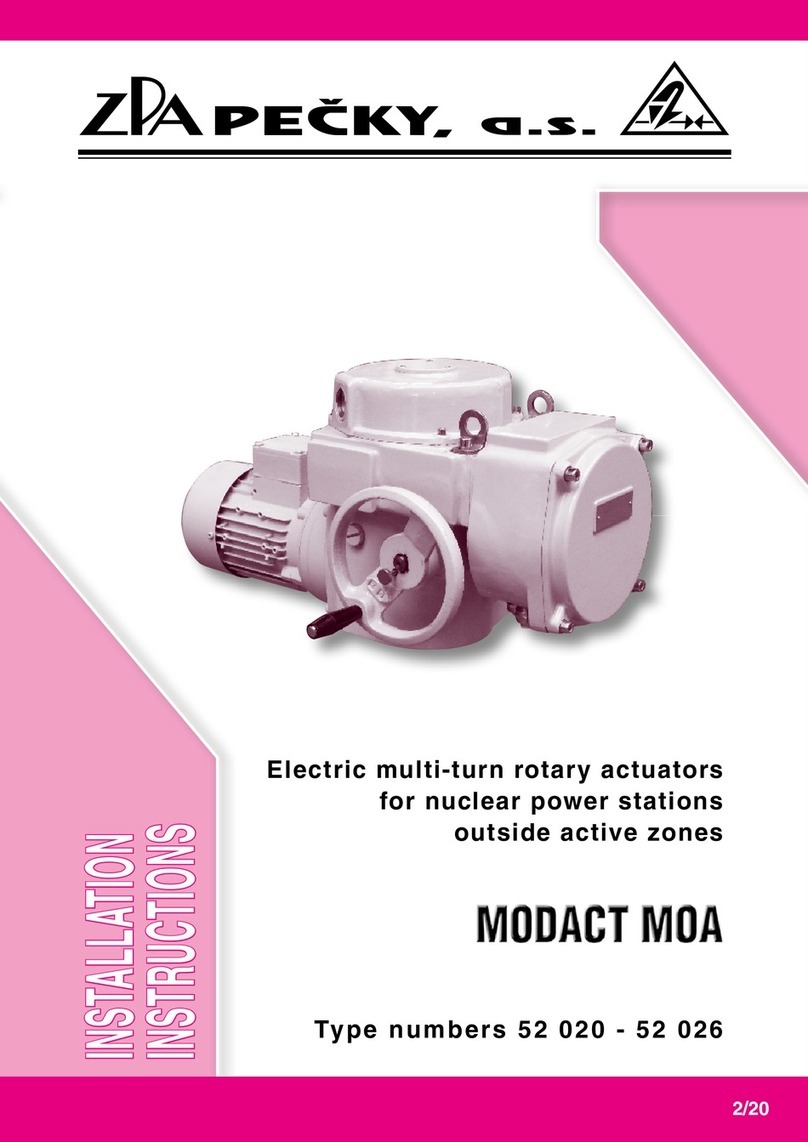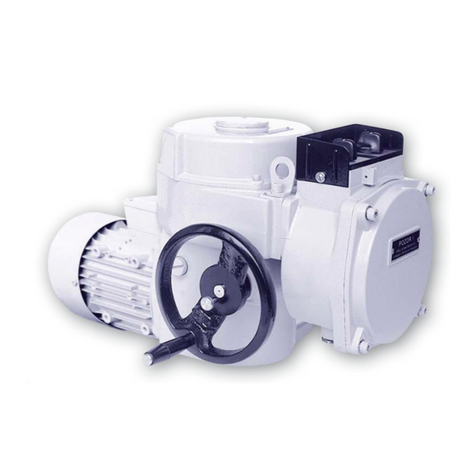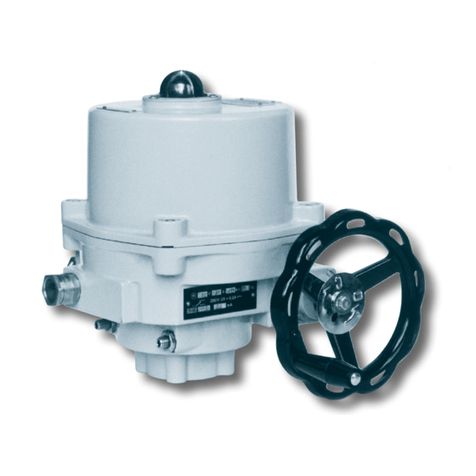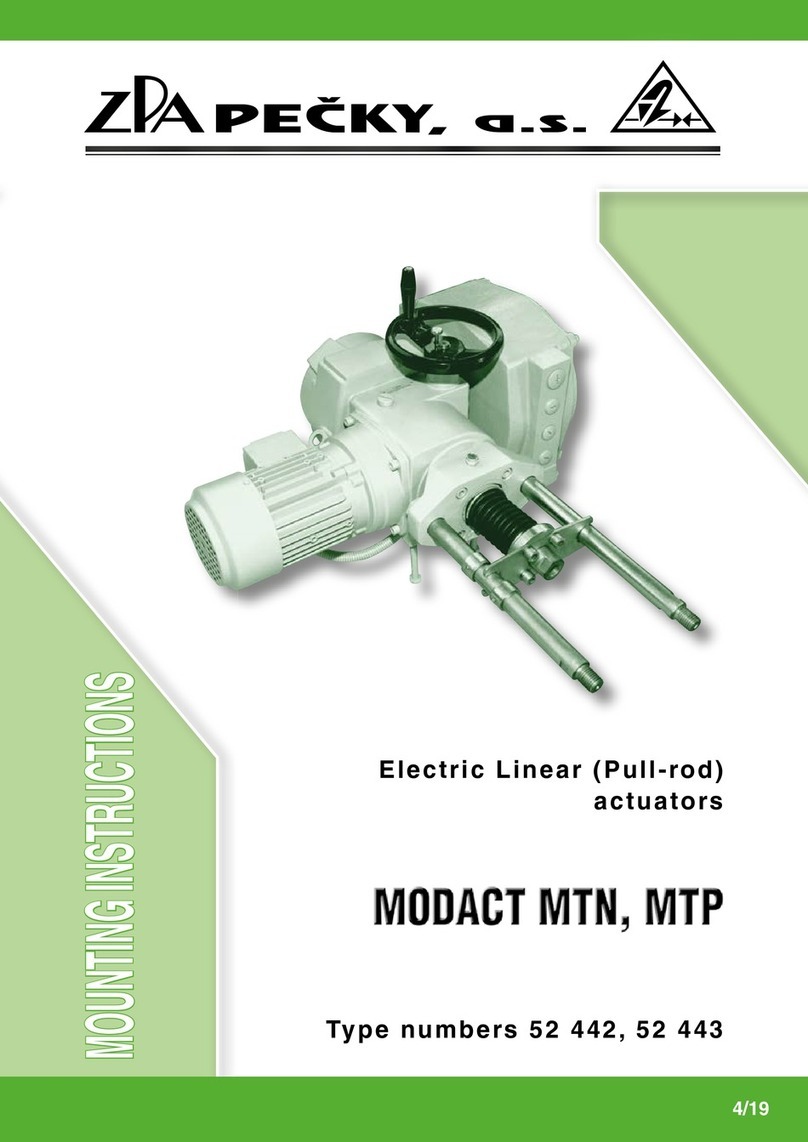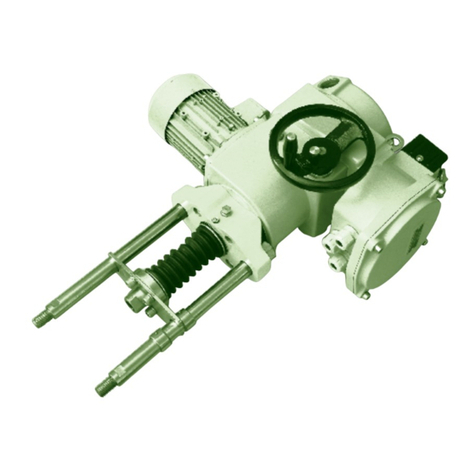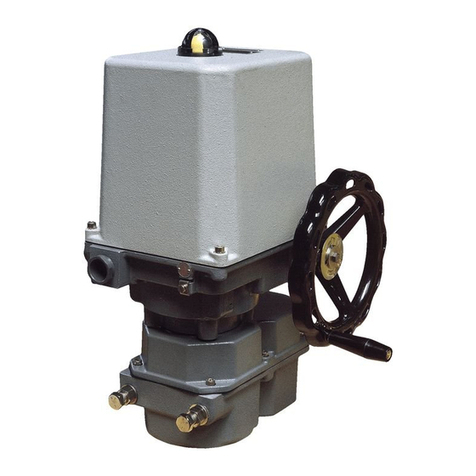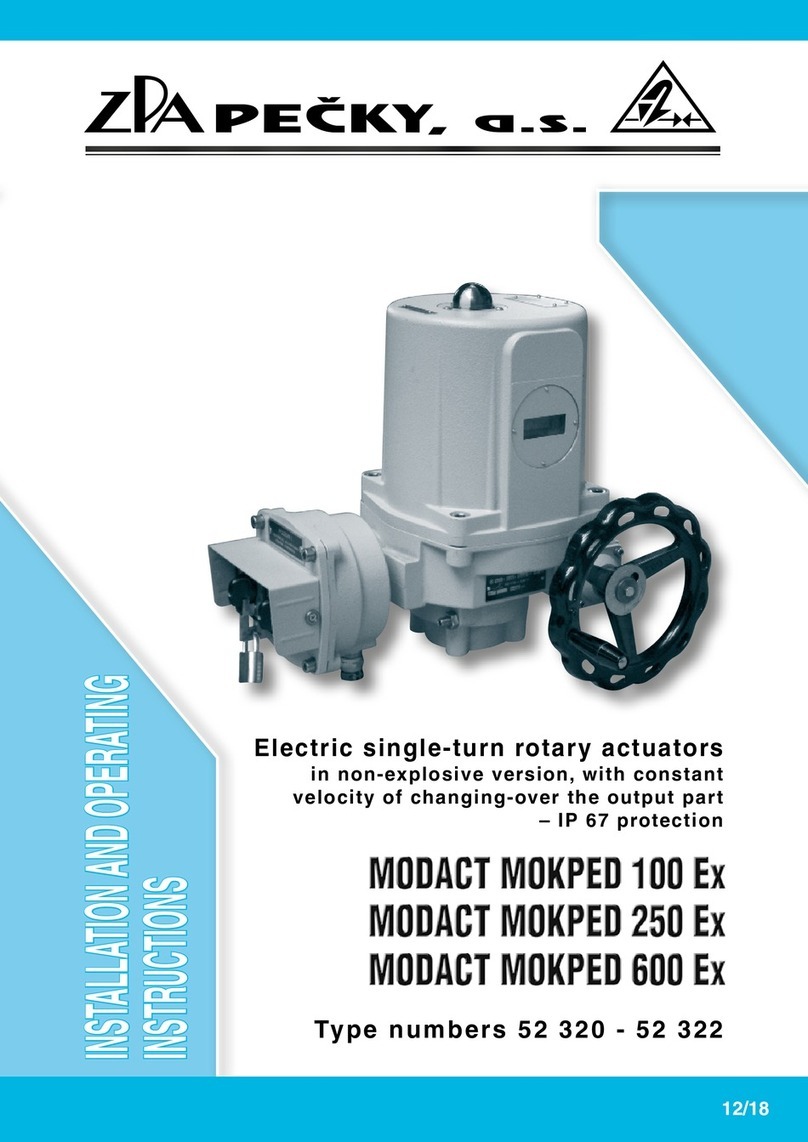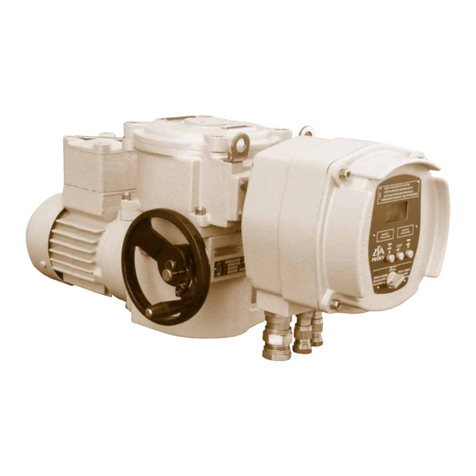
5
ČSN EN 60079-14
Regulations for electrical devices in areas with a danger of explosion of flammable gases and vapours.
ČSN IEC 60721 Types of environment for electrical devices.
ČSN 33 0371 Non-explosive mixtures. Classification and testing methods.
ČSN 34 3205 Operation of electric rotating machines and work with them.
ČSN EN 60079-11 Explosive atmospheres – Part 11: Protection of device by spark safety.
Data on actuators
The actuators are fitted with the following plates:
1) Plate with data of non-explosive closures:
2) Rating and instrument plate contains:
– manufacture's name and address
– type designation of product (type number)
– serial number
– year of production
– rated value of tripping torgue Nm
– rated speed of shifting 1/min
– rated working stroke rev
– designation of protective enclosure of actuator IP
– weight of actuator kg
– mark of conformity CE
– electrical data of power circuits (voltage and frequency, current and output of electric motor);
– electrical data of control circuit of micro-switches (voltage, current);
– position transmitter (current)
3) Warning plate
4) Plates on covers with marking of used protection against explosion
a) explosion-proof closure “d” of control box
b) secured version “e” of terminal board box
– without change-over switches of local control
– with change-over switches of local control
Návod k montáži a obsluze servomotorů MO EEx t.č.52120 až 52125 (verze 2017) Strana 3 (celkem 47)
1) Štítek s daty nevýbušných závěrů
nebo
nebo nebo pro t.č. 52 125
2) Štítek výrobní a přístrojový obsahuje
-označení a adresu výrobce
-typové označení výrobku (typové číslo)
-výrobní číslo
-rok výroby
-jmenovitá hodnota vypínacího momentu Nm
-jmenovitá rychlost přestavení 1/min
-jmenovitý pracovní zdvih ot
-označení krytí servomotoru IP
-hmotnost servomotoru kg
-značku shody CE
-elektrické údaje silového obvodu (napětí, frekvenci, proud a výkon elektromotoru)
-elektrické údaje ovládacího obvodu elektroniky (napětí, proud)
-vysílač polohy (proud)
3) Štítek výstražný
Návod k montáži a obsluze servomotorů MO EEx t.č.52120 až 52125 (verze 2017) Strana 3 (celkem 47)
1) Štítek s daty nevýbušných závěrů
nebo
nebo nebo pro t.č. 52 125
2) Štítek výrobní a přístrojový obsahuje
-označení a adresu výrobce
-typové označení výrobku (typové číslo)
-výrobní číslo
-rok výroby
-jmenovitá hodnota vypínacího momentu Nm
-jmenovitá rychlost přestavení 1/min
-jmenovitý pracovní zdvih ot
-označení krytí servomotoru IP
-hmotnost servomotoru kg
-značku shody CE
-elektrické údaje silového obvodu (napětí, frekvenci, proud a výkon elektromotoru)
-elektrické údaje ovládacího obvodu elektroniky (napětí, proud)
-vysílač polohy (proud)
3) Štítek výstražný
or
Návod k montáži a obsluze servomotorů MO EEx t.č.52120 až 52125 (verze 2017) Strana 3 (celkem 47)
1) Štítek s daty nevýbušných závěrů
nebo
nebo nebo pro t.č. 52 125
2) Štítek výrobní a přístrojový obsahuje
-označení a adresu výrobce
-typové označení výrobku (typové číslo)
-výrobní číslo
-rok výroby
-jmenovitá hodnota vypínacího momentu Nm
-jmenovitá rychlost přestavení 1/min
-jmenovitý pracovní zdvih ot
-označení krytí servomotoru IP
-hmotnost servomotoru kg
-značku shody CE
-elektrické údaje silového obvodu (napětí, frekvenci, proud a výkon elektromotoru)
-elektrické údaje ovládacího obvodu elektroniky (napětí, proud)
-vysílač polohy (proud)
3) Štítek výstražný
Návod k montáži a obsluze servomotorů MO EEx t.č.52120 až 52125 (verze 2017) Strana 3 (celkem 47)
1) Štítek s daty nevýbušných závěrů
nebo
nebo nebo pro t.č. 52 125
2) Štítek výrobní a přístrojový obsahuje
-označení a adresu výrobce
-typové označení výrobku (typové číslo)
-výrobní číslo
-rok výroby
-jmenovitá hodnota vypínacího momentu Nm
-jmenovitá rychlost přestavení 1/min
-jmenovitý pracovní zdvih ot
-označení krytí servomotoru IP
-hmotnost servomotoru kg
-značku shody CE
-elektrické údaje silového obvodu (napětí, frekvenci, proud a výkon elektromotoru)
-elektrické údaje ovládacího obvodu elektroniky (napětí, proud)
-vysílač polohy (proud)
3) Štítek výstražný
or or for type no. 52 125
Návod k montáži a obsluze servomotorů MO EEx t.č.52120 až 52125 (verze 2017) Strana 4 (celkem 47)
4) Štítky na krytech skříní s označením použité ochrany proti výbuchu
a) pevný závěr „d“ ovládací skříně
nebo nebo
b) zajištěné provedení „e“ svorkovnicové skříně
-bez přepínačů místního ovládání
nebo
-s přepínači místního ovládání
nebo nebo
Elektrické servomotory MODACT MO EEx v důlním provedení s označením I M2
Zákazník musí při objednávce uvést, že servomotor je určen pro použití v jiskrověbezpečných ovládacích
obvodech a pokud možno specifikovat jejich parametry. Na základětoho bude dodaný servomotor vybaven
příslušným topným odporem a označen následujícími údaji.
Štítek s daty nevýbušných závěrů
Štítek přístrojový
Štítek na krytu svorkovnicové skříně, která bude mít světle modrou povrchovou úpravu
Návod k montáži a obsluze servomotorů MO EEx t.č.52120 až 52125 (verze 2017) Strana 4 (celkem 47)
4) Štítky na krytech skříní s označením použité ochrany proti výbuchu
a) pevný závěr „d“ ovládací skříně
nebo nebo
b) zajištěné provedení „e“ svorkovnicové skříně
-bez přepínačů místního ovládání
nebo
-s přepínači místního ovládání
nebo nebo
Elektrické servomotory MODACT MO EEx v důlním provedení s označením I M2
Zákazník musí při objednávce uvést, že servomotor je určen pro použití v jiskrověbezpečných ovládacích
obvodech a pokud možno specifikovat jejich parametry. Na základětoho bude dodaný servomotor vybaven
příslušným topným odporem a označen následujícími údaji.
Štítek s daty nevýbušných závěrů
Štítek přístrojový
Štítek na krytu svorkovnicové skříně, která bude mít světle modrou povrchovou úpravu
Návod k montáži a obsluze servomotorů MO EEx t.č.52120 až 52125 (verze 2017) Strana 4 (celkem 47)
4) Štítky na krytech skříní s označením použité ochrany proti výbuchu
a) pevný závěr „d“ ovládací skříně
nebo nebo
b) zajištěné provedení „e“ svorkovnicové skříně
-bez přepínačů místního ovládání
nebo
-s přepínači místního ovládání
nebo nebo
Elektrické servomotory MODACT MO EEx v důlním provedení s označením I M2
Zákazník musí při objednávce uvést, že servomotor je určen pro použití v jiskrověbezpečných ovládacích
obvodech a pokud možno specifikovat jejich parametry. Na základětoho bude dodaný servomotor vybaven
příslušným topným odporem a označen následujícími údaji.
Štítek s daty nevýbušných závěrů
Štítek přístrojový
Štítek na krytu svorkovnicové skříně, která bude mít světle modrou povrchovou úpravu
Návod k montáži a obsluze servomotorů MO EEx t.č.52120 až 52125 (verze 2017) Strana 4 (celkem 47)
4) Štítky na krytech skříní s označením použité ochrany proti výbuchu
a) pevný závěr „d“ ovládací skříně
nebo nebo
b) zajištěné provedení „e“ svorkovnicové skříně
-bez přepínačů místního ovládání
nebo
-s přepínači místního ovládání
nebo nebo
Elektrické servomotory MODACT MO EEx v důlním provedení s označením I M2
Zákazník musí při objednávce uvést, že servomotor je určen pro použití v jiskrověbezpečných ovládacích
obvodech a pokud možno specifikovat jejich parametry. Na základětoho bude dodaný servomotor vybaven
příslušným topným odporem a označen následujícími údaji.
Štítek s daty nevýbušných závěrů
Štítek přístrojový
Štítek na krytu svorkovnicové skříně, která bude mít světle modrou povrchovou úpravu
Návod k montáži a obsluze servomotorů MO EEx t.č.52120 až 52125 (verze 2017) Strana 4 (celkem 47)
4) Štítky na krytech skříní s označením použité ochrany proti výbuchu
a) pevný závěr „d“ ovládací skříně
nebo nebo
b) zajištěné provedení „e“ svorkovnicové skříně
-bez přepínačů místního ovládání
nebo
-s přepínači místního ovládání
nebo nebo
Elektrické servomotory MODACT MO EEx v důlním provedení s označením I M2
Zákazník musí při objednávce uvést, že servomotor je určen pro použití v jiskrověbezpečných ovládacích
obvodech a pokud možno specifikovat jejich parametry. Na základětoho bude dodaný servomotor vybaven
příslušným topným odporem a označen následujícími údaji.
Štítek s daty nevýbušných závěrů
Štítek přístrojový
Štítek na krytu svorkovnicové skříně, která bude mít světle modrou povrchovou úpravu
or
or or
Návod k montáži a obsluze servomotorů MO EEx t.č.52120 až 52125 (verze 2017) Strana 4 (celkem 47)
4) Štítky na krytech skříní s označením použité ochrany proti výbuchu
a) pevný závěr „d“ ovládací skříně
nebo nebo
b) zajištěné provedení „e“ svorkovnicové skříně
-bez přepínačů místního ovládání
nebo
-s přepínači místního ovládání
nebo nebo
Elektrické servomotory MODACT MO EEx v důlním provedení s označením I M2
Zákazník musí při objednávce uvést, že servomotor je určen pro použití v jiskrověbezpečných ovládacích
obvodech a pokud možno specifikovat jejich parametry. Na základětoho bude dodaný servomotor vybaven
příslušným topným odporem a označen následujícími údaji.
Štítek s daty nevýbušných závěrů
Štítek přístrojový
Štítek na krytu svorkovnicové skříně, která bude mít světle modrou povrchovou úpravu
Návod k montáži a obsluze servomotorů MO EEx t.č.52120 až 52125 (verze 2017) Strana 4 (celkem 47)
4) Štítky na krytech skříní s označením použité ochrany proti výbuchu
a) pevný závěr „d“ ovládací skříně
nebo nebo
b) zajištěné provedení „e“ svorkovnicové skříně
-bez přepínačů místního ovládání
nebo
-s přepínači místního ovládání
nebo nebo
Elektrické servomotory MODACT MO EEx v důlním provedení s označením I M2
Zákazník musí při objednávce uvést, že servomotor je určen pro použití v jiskrověbezpečných ovládacích
obvodech a pokud možno specifikovat jejich parametry. Na základětoho bude dodaný servomotor vybaven
příslušným topným odporem a označen následujícími údaji.
Štítek s daty nevýbušných závěrů
Štítek přístrojový
Štítek na krytu svorkovnicové skříně, která bude mít světle modrou povrchovou úpravu
Návod k montáži a obsluze servomotorů MO EEx t.č.52120 až 52125 (verze 2017) Strana 4 (celkem 47)
4) Štítky na krytech skříní s označením použité ochrany proti výbuchu
a) pevný závěr „d“ ovládací skříně
nebo nebo
b) zajištěné provedení „e“ svorkovnicové skříně
-bez přepínačů místního ovládání
nebo
-s přepínači místního ovládání
nebo nebo
Elektrické servomotory MODACT MO EEx v důlním provedení s označením I M2
Zákazník musí při objednávce uvést, že servomotor je určen pro použití v jiskrověbezpečných ovládacích
obvodech a pokud možno specifikovat jejich parametry. Na základětoho bude dodaný servomotor vybaven
příslušným topným odporem a označen následujícími údaji.
Štítek s daty nevýbušných závěrů
Štítek přístrojový
Štítek na krytu svorkovnicové skříně, která bude mít světle modrou povrchovou úpravu
or or
